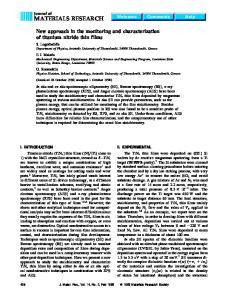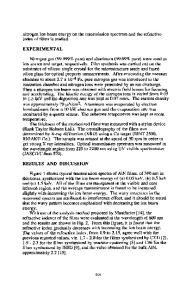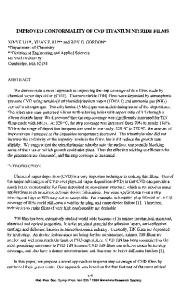In-Situ Optical Characterization of Titanium Nitride Thin Films for Applications in Microelectronics
- PDF / 914,648 Bytes
- 6 Pages / 420.48 x 639 pts Page_size
- 72 Downloads / 356 Views
ABSTRACT Titanium Nitride (TiN,,) thin films were deposited on Si(100) by reactive magnetron sputtering. The varied deposition conditions were the substrate temperature (Td) (27 - 650 'C) and the negative bias voltage (Vb) applied to the substrate (0 - 200 V) in order to produce TiNX films with various compositions and structural characteristics. The deposition process was monitored in-situ by Spectroscopic Ellipsometry in the spectral range 1.5-5.5 eV. Determination of the film composition was made through the measured screened plasma energy wps while the electrical resistivity of TiNX was studied in terms of the unscreened plasma energy wpu. wO,,was calculated by an optical model including a Drude term and Lorentz oscillator terms and their dependence on Td and Vb was studied. The 0opu was found to increase with Vb until a saturation value was obtained. The saturation value of 0wpdepends on the Td. (Opu describes better the TiNx films, since it is directly correlated with their metallic character in terms of the electrical resistivity.
INTRODUCTION Titanium nitride (TiNx) thin films ([N)/[Ti]-I) have lately gained much interest in different areas of semiconductor device technology, such as diffusion barriers, gate electrodes in field-effect transistors, contact layers in solar cells and a replacement of polycrystalline Si in very-large-scale metal-oxide-semiconductor integrated circuits [1-4]. Auger Electron Spectroscopy (AES) and X-ray Photoelectron Spectroscopy (XPS) have been used in the past for the characterization of this type of films [5,6]. However, the above and other analytical techniques used for composition analysis are destructive and may suffer from inherent difficulties since they usually require the exposure of the TiNx films to air. Optical non-destructive access to a surface in vacuum is important for real-time monitoring, control and characterization during film development. In-situ Spectroscopic Ellipsometry (SE) is a surface sensitive optical technique used to monitor deposition rates and composition of films during deposition and can be used in a complementary manner with other post-deposition techniques. Here we present an in-situ monitoring process of TiNx composition and metallic character by analyzing SE data. The optical properties depend strongly on the composition and the structural characteristics of the TiNx films. Of special interest is the unscreened plasma energy hcopu of the material. In an ideal metal with all electrons free, ho,, is defined by the energy position where the real part of the dielectric function E(o) is equal to zero (F,=0). However, the existence of interband transitions (bonded electrons) which are responsible for the colour of the films, at energies lower than hopu, shifts E1=0 and hOp, to lower energy. This energy is called screened plasma energy h~ops. The discrimination between Op, and (0ps was succeded using a 113 Mat. Res. Soc. Symp. Proc. Vol. 569 ©1999 Materials Research Society
model to describe the optical response including a Drude (free electrons
Data Loading...








